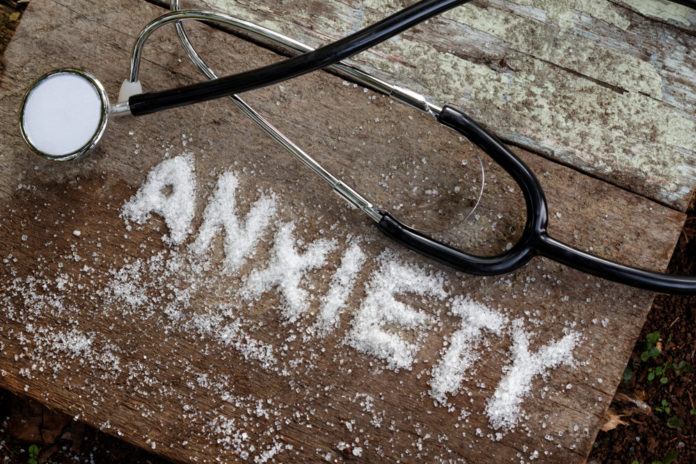Sugar (noun): The latest villain reigning the obesity and diabetes epidemic the U.S. is facing.
While the sweet stuff is in the spotlight for its ramifications on physical health, the link between anxiety and blood sugar should not be dimmed.
What Is Anxiety?
Anxiety can be a normal, even productive reaction to certain situations, including feeling anxious when giving or presentation. The physiological response helps prepare a sensible reaction when faced with a challenge.
Chronic anxiety, on the other hand, may indicate an anxiety disorder and severely interfere and disrupt daily life. Anxiety can also manifest as physical symptoms including muscle tension, headaches, trembling, restlessness, sweating, abdominal upsets, dizziness and irritability. What’s more, there is an area of interest linking anxiety and blood sugar.
Understanding Blood Sugar
Blood sugar, or glucose, is the main sugar found in your blood. When carbs are consumed, it becomes broken down to glucose, in which the blood carries it to the body’s cells and uses it for energy.
Under normal conditions, blood sugars still within a normal range and cells are supplied with the glucose. But if managing type I or II diabetes, taking certain medications, deficient in specific hormones, and handling other health conditions, there might be a risk of blood sugars becoming too low or high:
Low Blood Sugar: Also known as hypoglycemia, low blood sugar is when blood sugar levels fall at or below 70 milligrams per deciliter (mg/dL) or 3.9 millimoles per liter (mmol/L).
High Blood Sugar: Mostly concerned with diabetes, high blood sugar (hyperglycemia) is generally when blood glucose exceeds 200 mg/dL or 11.1 mmol/L.
The Link Between Anxiety and Blood Sugar
While there is still more to be known regarding the relationship between anxiety and blood sugar, there is sufficient evidence and hypotheses that link the two, including:
Managing blood sugars increases the risk of anxiety.
According to the findings from the 2006 Behavioral Risk Factor Surveillance System, people with diabetes had a 20 percent higher prevalence of lifetime diagnosis of anxiety than those without. A complementary 2013 meta-analysis, featuring a total of twelve studies with data for 12,626 people with diabetes, supports that diabetes is associated with an increased likelihood of having anxiety disorders and elevated anxiety symptoms.
Diabetes may provoke anxiety related to:
- Anticipating a diagnosis. Some people have anxiety before a definitive diagnosis.
- Managing the condition itself. Anxiety may be triggered by specific fears associated with managing diabetes, including the risks of hypoglycemia or developing complications, including neuropathy and chronic kidney disease.
- Worrying about judgment from others. Some people may be worried about what others think, which may result to noncompliance to diabetes management i.e. avoiding insulin injections in public or altogether.
Managing Diabetes with Confidence
If feeling anxious about managing diabetes, seek out the support from family members and friends and consult with a primary care provider, dietitian, diabetes educator, and other interdisciplinary team members as needed.
Their provision of care can not only help identify methods to control blood sugars, but instill confidence to do so and disseminate the risk of anxiousness surrounding the condition.
Eating based on anxiety and stress may eventually impact blood sugars.
Whether based on meeting a deadline at work, worrying about financial matters, or dealing with a close friend’s death, unwanted emotions may knock at the door, intrude in, and overstay their welcome.
During such times of stress, anxiety, anger, worry, and other negative feelings, seeking out food for comfort measures is not too unlikely: Emotions have a strong tie and bond to diet choices and unfortunately, the chosen foods tend to be rich in sugar, fat, and calories and consumed in large volumes.
Emotional eating can be further fueled by dopamine, also known as the “feel good hormone.” Especially in strong emotional bouts, taking to food can release dopamine and activate the reward and pleasure centers and potentially diminish the efficiency of satiety cues (or feeling full), subsequently consuming foods in excess. The art of sugar’s renowned addictive properties can further instigate emotional eating and fuel the drive towards its intake.
While these feelings may feel resolved in the moment, the cycle often continues and places significant risk of weight gain, insulin resistance, and diabetes, therefore creating a link between anxiety and high blood sugar.
How to Gain Control of Emotional Eating
Gain control over emotional eating by eating mindfully, managing stress, and allowing indulgences every now and then. Also seek out care from a professional counselor or psychologist if unable to control emotional eating, as they can help identify and release inner causes of the emotions while exploring appropriate coping strategies.
A striking resemblance exists between hypoglycemia and anxiety attacks.
Anxiety and panic attack symptoms mimic those of hypoglycemia: A panic attack is a sudden feeling of intense fear or discomfort that strikes repeatedly without warning, while hypoglycemia is a medical event in which blood sugar falls below normal. Although the two are vastly different phenomena, the signs and symptoms of each resemble one another.
According to the Anxiety and Depression Association of America, a panic attack reaches a peak within minutes and includes at least four of the following symptoms:
- Palpitations, pounding heart, or accelerated heart rate
- Sweating
- Trembling or shaking
- Sensations of shortness of breath or smothering
- Feelings of choking
- Chest pain or discomfort
- Nausea or abdominal distress
- Feeling dizzy, unsteady, light-headed, or faint
- Chills or heat sensations
- Paresthesia (numbness or tingling sensations)
- Derealization (feelings of unreality) or depersonalization (being detached from oneself)
- Fear of losing control, “going crazy,” or of dying
Similarly, hypoglycemia can happen quickly and result to the following signs and symptoms according to the American Diabetes Association (ADA):
- Feeling shaky, dizzy, or lightheaded
- Being nervous or anxious
- Sweating, chills and clamminess
- Irritability or impatience
- Confusion
- Fast heartbeat
- Hunger
- Nausea
- Color draining from the skin (pallor)
- Feeling fatigued, weak, or sleepy
- Blurred/impaired vision
- Tingling or numbness in the lips, tongue, or cheeks
- Headaches
- Coordination problems and clumsiness
- Nightmares or crying out during sleep
- Seizures
What’s frightening is that hypoglycemia can be a dangerous, even life-threatening condition if not promptly treated. And unfortunately, it is nearly impossible to detect hypoglycemia without using a glucometer. So if suspicious if either, implement the “15-15” rule to help treat hypoglycemia and prevent such serious consequences.
The 15-15 Rule to Treat Hypoglycemia
Consume 15 grams of carbohydrate to raise your blood glucose and check it after 15 minutes. If it’s still below 70 mg/dL, have another 15 gram serving. The following are examples of 15 grams of carb:
- 4 ounces (or ½ cup) of juice or regular soda
- 8 ounces (or 1 cup) of milk
- 1 tablespoon of sugar or honey
- Hard candies or jelly beans – review food label to see how many equate to 15 grams
- Glucose tabs or gels – also read the label and instructions









